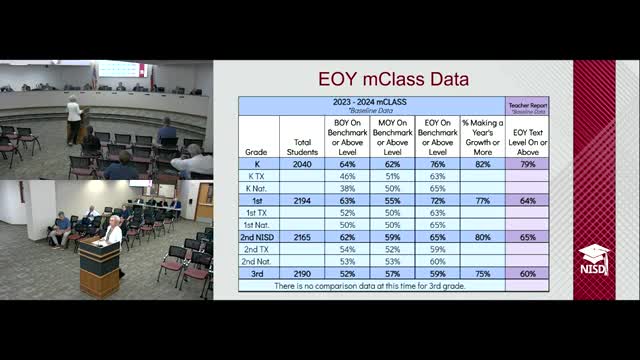Schools celebrate impressive academic growth despite challenges
June 27, 2024 | NORTHWEST ISD, School Districts, Texas

This article was created by AI summarizing key points discussed. AI makes mistakes, so for full details and context, please refer to the video of the full meeting. Please report any errors so we can fix them. Report an error »

In a recent government meeting, education officials reported significant academic growth among students, particularly in grades K-2, where they outperformed both state and national averages. The data revealed that a substantial percentage of students achieved a year’s growth or more, highlighting the dedication of teachers in addressing individual student needs.
The discussion included an analysis of end-of-year MAP assessment data, with a goal set for students to score above the 50th percentile nationally. While most grade levels showed promising results, there was a noted decline in middle school performance, particularly in English Language Arts (ELA). Officials emphasized the need to focus on improving these scores in the upcoming school year.
The meeting also addressed the effectiveness of interim assessments, which provided predictive insights into student performance. Although there was some discrepancy in the correlation between interim assessments and actual STAR test results, officials expressed satisfaction with the overall performance, particularly at the meets and masters levels, where students outperformed regional and state averages.
Concerns were raised regarding 4th-grade performance, which lagged behind other grades. Education leaders are investigating the underlying causes, as this trend was echoed in surrounding districts. Despite this, the overall sentiment was one of celebration, as the district continues to monitor academic progress and adjust strategies to meet the evolving educational landscape.
Looking ahead, officials plan to maintain interim assessments at the elementary level to provide students with necessary practice, while secondary levels will rely on internal benchmarks. The meeting concluded with a commitment to closely track the performance of subpopulations to ensure equitable educational outcomes for all students.
The discussion included an analysis of end-of-year MAP assessment data, with a goal set for students to score above the 50th percentile nationally. While most grade levels showed promising results, there was a noted decline in middle school performance, particularly in English Language Arts (ELA). Officials emphasized the need to focus on improving these scores in the upcoming school year.
The meeting also addressed the effectiveness of interim assessments, which provided predictive insights into student performance. Although there was some discrepancy in the correlation between interim assessments and actual STAR test results, officials expressed satisfaction with the overall performance, particularly at the meets and masters levels, where students outperformed regional and state averages.
Concerns were raised regarding 4th-grade performance, which lagged behind other grades. Education leaders are investigating the underlying causes, as this trend was echoed in surrounding districts. Despite this, the overall sentiment was one of celebration, as the district continues to monitor academic progress and adjust strategies to meet the evolving educational landscape.
Looking ahead, officials plan to maintain interim assessments at the elementary level to provide students with necessary practice, while secondary levels will rely on internal benchmarks. The meeting concluded with a commitment to closely track the performance of subpopulations to ensure equitable educational outcomes for all students.
View full meeting
This article is based on a recent meeting—watch the full video and explore the complete transcript for deeper insights into the discussion.
View full meeting
